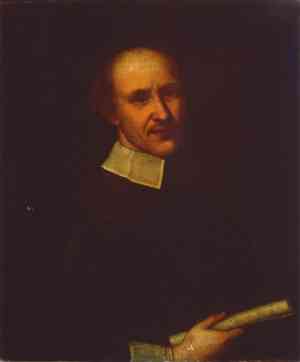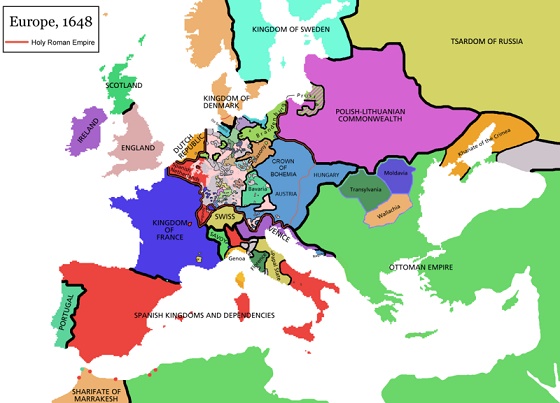


Giovanni Legrenzi
Source:
Wikipedia
Baptized on 12 August 1626 in Clusone, Republic of Venice, Giovanni Legrenzi was a well-advanced composer born about a quarter century after the emergence of baroque. He had a violinist and composer for a father who taught him music as a youth. Giovanni's earliest known employment is as an organist at the Basilica di Santa Maria Maggiore in Bergamo in 1645 where he remained until 1656. He was ordained as a priest in 1651.

Legrenzi's Europe at about age 22
Source: Wikipedia
Legrenzi first published in 1654 in Venice, a book of music for Mass and Vespers called 'Concerti Musicali' (Op 1). 'Sonata a due, e tre' (Op 2) followed in 1655.
'La Foscari' Sonata by Giovanni Legrenzi
No.8 of 'Sonata a due, e tre' Op 2 pub 1655
Composed for voice, violin, violone or bassoon & continuo
Ensemble Baroque de Nice directed by Gilbert Bezzina 2002
The works of Legrenzi are divided into four main groups. The first are his published works which are assigned opus numbers 1 through 19 such that each opus equals a published book. Opera 18 and 19 are lost, leaving 17. Opera 16 and 17 were published posthumously, leaving fifteen surviving books published in Legrenzi's lifetime, 'Sacri Musicali Concerti' (Op 15) of 1689 the last he would see to print. There was considerable confusion for several years during Legrenzi's lifetime surrounding the matter of two Op 10s. This needn't complicate things for us here, though I address that problem in a footnote below.
Legrenzi is next grouped into operas, oratorios and unpublished works (some entered into manuscripts), none of which are assigned opus numbers. Nor do "PR" numbers (Passadore/Rossi) in Legrenzi concern us herein, though addressed in footnotes below.
In 1656 Legrenzi became maestro di cappella at the Academy of the Holy Spirit until 1665, that a fraternity of musicians who supplied music in Ferrara. The next year (1657) saw 'Salmi a cinque, tre voci, e due violini' (Op 5) published in Venice.
'Dixit Dominus Domino Meo' Setting to Psalm 109 by Giovanni Legrenzi
'Said the Lord to My Lord'
No.2 of 'Salmi a cinque, tre voci, e due violini' Op 5 pub 1657
Composed for STB, 2 violins & continuo
Cantores Musicæ Antiquæ directed by Jeffery Kite-Powell
Italian baroque emerging in tandem with opera had a history of about six decades by the time Legrenzi completed his first of nineteen, 'Nino, il giusto' ('Nino, the just'), performed in 1662 in Ferrara. His second opera, 'L'achille in Sciro', premiered in 1663 in Ferrara. Partnering w librettist, Ippolito Bentivoglio, that was greatly successful, his name now arriving to some note. Along w operas Legrenzi wrote numerous oratorios. Oratorios are grand choral and instrumental works like opera but without stage, made more to hear than watch. His first, 'Oratorio del giuditio', premiered in Vienna in 1665. Legrenzi wrote at least ten oratorios before the arrival of his last, 'Erodiade', in 1687.
In 1670 Legrenzi was appointed Maestro di Musica at the Ospedale Santa Maria dei Derelitti in Venice, more commonly called the Ospedaletto. By that time he owned land in Clusone, comfortable of numerous published works and several operas. Unable to identify where it was composed, I here insert Legrenzi's sacred work, 'Dies Irae', of circa 1670 per 'Grove's Dictionary of Music and Musicians' [Requiem Survey]. It may well fit here as it was written for double choir a 8, pursuant of Venetian form ever since Adrian Willaert introduced the split choir at St. Mark's in 1527. The "Dies Irae' ('Day of Wrath' aka 'Judgment Day') had long since been part of the Roman Catholic Requiem Mass and has been a popular subject for composers. Uncertain authorship has it possibly originating anytime from the 6th to 13th century. Legrenzi's 'Dies Irae' survives in manuscript in Paris.
'Dies Irae' For the Requiem Mass by Giovanni Legrenzi
Composed for double choir (8 voices) w instruments c 1670
Ricercar Consort / Philippe Pierlot
Works more certainly completed while Legrenzi served at the Ospedaletto include 'La Cetra' in 1673. This is Op 11 first published in error as Op 10. It is nevertheless commonly referred to as the original Op 10. The cetra is a stringed instrument similar to the lyre. Legrenzi also completed his fifth opera, 'Eteocle E Polinice', while at the Ospedaletto, that premiering in 1674 followed by among his most popular operas, 'La divisione del mondo' premiering at the Teatro San Salvador in Venice on 4 Feb 1675.
'Trio Sonata' Sonata for cetra by Giovanni Legrenzi
No.3 of 'La Cetra' Op 11 pub 1673 (originally Op 10 by publishing error)
Composed for cetra & 2 violins
Ensemble Baroque de Nice directed by Gilbert Bezzina
'Che Fiero Costume' ('What a Proud Costume') Giovanni Legrenzi
From the opera 'Eteocle E Polinice' premiering 1674
Tenor: Richard Tucker
'Lumi, potete piangere' ('Eyes, you can cry') Giovanni Legrenzi
From the opera 'La divisione del mondo' premiering in Venice 4 Feb 1675
Libretto: Giulio Cesare Corradi
Soprano duet: Ana Torbica & Tara Venkatesan w members of the New Trinity Baroque 2002
Legrenzi became Maestro di Coro of the Ospedale dei Mendicanti in 1676 until 1682. A star composer by then, this increased in magnitude upon the premiere of 'Il Giustino' at the Teatro San Salvador in Venice on 7 Feb 1683. He followed that the next year with his highly successful 'Publio Elio Pertinace'.
Legrenzi was appointed Maestro di Cappella at San Marco (St. Mark's Basilica) in April 1685, followed by his final opera, 'Ifianassa e Melampo', that autumn. His last of fourteen oratorios, 'Erodiade', appeared in 1687. His final book to see publishing during his lifetime was 'Sacri Musicali Concerti a due, e tre voci' (Op 15). Opera 16-19 were all published posthumously, 'Balletti e Correnti a cinque stromenti' (Op 16) in 1691, 'Motetti Sacri a voce sola con tre strumenti' (Op 17) in 1692, 'Sonate a 2, 3, 4, 5, 6 e 7 istrumenti' (Op 18) in 1693 and 'Voci geniali, raccolte in duetti e terzetti' (Op 19) in 1698. Opera 18 and 19 are lost.
'Non Susurate' Motet by Giovanni Legrenzi
No.9 of 'Motetti Sacri a voce sola con tre strumenti' Op 17 pub posthumously 1692
Soprano: Anna Hlavenková w the Ensemble Musica Antique Prague 1996
Legrenzi's health had begun to falter by the time he became Maestro at San Marco, less and less able to perform. He is thought to have died in the horrible pain of kidney stones on 27 May 1690. His opera 18 and 19 were published in 1693 and 1698 in Venice titled.
Note on opus numbers (1-19) in Legrenzi: These were assigned to published books, none to his operas, oratorios or unpublished works. This was due to necessity upon a couple of volumes mistakenly introduced as his tenth. His first opus, 'Concerti Musicali', had been described as "Opera Prima" on the title page, not Opus 1. In 1670 his 'Acclamationi Divote' consisting of motets was described as 'Opera X' [facsimile 1688]. Three years later his 'La Cetra' was erroneously printed as 'Opera Decima'. As both couldn't be his tenth, a revised copy of 'Acclamationi Divote' remedied the problem by describing it as 'Opera Xi', the small "i" indicating a plural. Following 'La Cetra', Legrenzi's 'Cantate e Canzonette' [IMSLP / Internet Archive] was correctly labeled his twelfth in 1676, although 'La Cetra' was reissued in 1682 once again erroneously as his tenth. "What a lot of baloney!" he might have shouted by now, both editions printed in Bologna. Eventually 'Acclamationi Divote' became as it was, Op 10, 'La Cetra' became Op 11 and 'Cantate e Canzonette' Op 12.
Note on "PR" numbers: See 'La sottigliezza dell'intendimento: catalogo tematico di Giovanni Legrenzi' by Francesco Passadore & Franco Rossi / Venice / 2002.
Sources & References for Giovanni Legrenzi:
Abendmusiken in der Predigerkirche (Program of 12 August 2018)
Anne Feeney (All Music)
Aryeh Oron (Bach Cantatas / lists of works)
VF History (notes)
Preceden Timelines
People Pill (lists of works)
Wikipedia (lists of works)
Audio of Legrenzi: Classical Archives
Compositions / Works:
Operas (19 from 1662-1685)
Oratorios (11 or so from 1665-1687)
Published (Opera 1-19 / 18-19 lost / 1654-1698)
Unpublished (sacred)
Lyrics / Texts:
Dies Irae (sequence for Roman Catholic Funeral Mass / authorship uncertain)
Operas: Individual: Chronological (incomplete):
Nino, il giusto (1st of 19 / premiere Ferrara 1662)
L'achille in Sciro (2nd of 19 / premiere Ferrara 1663)
Zenobia e Radamisto (3rd of 19 / premiere Ferrara 1665)
Eteocle e Polinice (5th of 19 / premiere Venice 1674)
La divisione del mondo (6th of 19 / premiere Venice 1675):
Totila (9th of 19 / premiere Venice 1677)
Il Giustino (16th of 19 / premiere Venice 1683)
Ifianassa e Melampo (19th of 19 / premiere 1685)
Publications: Editions: Wikipedia
Publications: Individual: Chronological (incomplete):
Concerti Musicali (Op 1 of 19 / music for Mass and Vespers / Venice 1654)
Sonata a due, e tre (Op 2 of 19 / 18 sonatas / Venice 1655)
Salmi a cinque, tre voci, e due violini (Op 5 of 19 / Psalms for Festal Vespers / Venice / 1657):
Acclamationi Divote a voce sola (Op 10 of 19 / Bologna / 1670):
La Cetra (Op 11 of 19 / Venice / 1673)
Cantate e Canzonette (Op 12 of 19 / Bologna / 1676):
Publio Elio Pertinace (18th of 19 operas / facsimile / Venice 1684)
Recordings of Legrenzi: Catalogs:
Recordings of Legrenzi: Select:
Concerti Musicali by the Oficina Musicum Chorus & Ensemble on Dynamic 2010:
Sonate E Motetti by Musica Antiqua Praha directed by Pavel Klikar on Supraphon 1997
Scores / Sheet Music: Corpus:
Choral Facsimiles IMSLP Musicalics ScorSer
Scores / Sheet Music: Individual:
Dixit Dominus (setting to Psalm 119 / pub 1657)
Further Reading:
Luigi Collarile (Sacri concerti / 2010)
Bibliography:
Luigi Collarile (Legranzi perduto: Appunti di bibliografia / Studi Musicali 38 / 2009)
François-Joseph Fétis (Biographie universelle des musiciens Vols. 5-6 / 1867)
Julie Anne Sadie (Companion to Baroque Music / University of California Press / 1998)
Eleanor Selfridge-Field (A new chronology of Venetian opera / Stanford University Press / 2007)
J.D. Swale (A thematic catalogue of the music of Giovanni Legrenzi / University of Adelaide / 1983)
Authority Search: VIAF World Cat
Other Profiles: Britannica Encyclopedia Chris Whent (HOASM)
Classical Main Menu Modern Recording
hmrproject (at) aol (dot) com